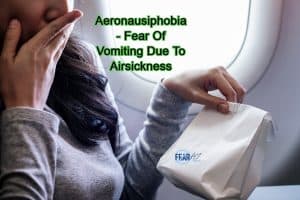Share This Article
Aeronausiphobia – Another Reason to Fear Flying?
Do you reach for the small complimentary bag the minute you board the plane?
How many times have you canceled a flight because of your crippling fear of throwing up while you’re in the air? Does this fear of being airsick worry you so much that you can’t think straight? Do you avoid plane rides at all costs, even if it makes you miss important events?
This irrational fear can significantly limit your life. For many, it puts them in a constant state of anxiety. Thankfully, there are ways to treat this fear!
If you get nauseous at the mere thought that you might vomit on a plane, you may have aeronausiphobia or a fear of vomiting due to airsickness. This phobia is manageable, however, and you can regain control over your life with a combination of self-help methods and professional therapy.

What You Need to Know about Aeronausiphobia
Aeronausiphobia is the medical term for the fear of throwing up resulting from airsickness. It may result from a combination of different phobias—emetophobia, which is a fear of vomiting, and aviophobia, which is a fear of airplanes.
Aeronausiphobia is not as common as other phobias, which makes it difficult for people dealing with this condition to learn more about it and how to manage it. You may encounter it if you refer to a list of phobias or if you have your mind set on understanding what you’re experiencing.
Like other phobias, this is an irrational fear, but it can still have debilitating effects. Today, however, there are many ways in which one can deal with the fear and overcome it.
A Proven Self-Help Program for How to Get Over Aeronausiphobia Fast
What Causes Fear of Vomiting Due to Airsickness?
Aeronausiphobia causes are not yet completely understood. However, experts believe this phobia is a combination of genetic (inherited) and environmental factors.
Take a look at some possible causes below.
Prior Traumatic Experience
You may have experienced a traumatic event involving airsickness or motion sickness, such as becoming sick in an airplane. It is also possible that you have thought about it too often and learned to fear it.
Medical Factors
Studies suggest that phobias may run in families, which implies a genetic component. Individuals with a history of anxiety disorders may also be more vulnerable to acquiring phobias.
Chemical imbalance in the brain may also be involved in phobia development, as it can lead to an exaggerated fear of stimuli.
Social or Cultural Factors
With certain phobias, one’s culture or society may also play a role in their development. For example, if a person doesn’t encounter a particular situation often, such as flying, it may create fear about that situation.
Symptoms of Aeronausiphobia
Diagnosing aeronausiphobia can be challenging, because symptoms may differ among individuals, ranging from barely noticeable to debilitating. Aeronausiphobia symptoms can manifest both physically and psychologically.
Physical Symptoms:
- Fast heartbeat
- Palpitations
- Chest pain
- Breathlessness
- Excessive sweating
- Shaking
- Nausea
- Hot flashes
- Chills
- Tingling
- Numbness
- Tiredness
Psychological Symptoms:
- Intense fear when imagining a situation that may cause airsickness
- Avoiding situations that may cause motion sickness
- Difficulty concentrating
- Irrational worries or beliefs about motion or airsickness
- Replaying thoughts and memories about being sick
- Irritability
- Restlessness
- Insomnia
- Depression
- Hopelessness
- Shame about the fear
- Social withdrawal
- Disengagement
- Panic attacks or general anxiety when experiencing motion discomfort
Individuals with aeronausiphobia may experience some or all of these symptoms, which may worsen depending on how airsick they become.
Aeronausiphobia Treatment
How can I calm my fear of vomiting? Although there is no specific cure for any phobia, here are some helpful options.
Aeronausiphobia Self-Help
Before considering seeking professional treatment, you might try self-help techniques first. Let’s take a look at how to overcome fear of sickness on your own.
Write down or record your thoughts about airsickness to identify the patterns that cause this fear. Consider sharing your fears and anxieties with trusted friends and family members. Joining support groups is also a good idea, as it can help you realize that you’re not alone.
You may also consider learning relaxation techniques, such as taking deep breaths, meditating, and repeating positive affirmations. Practice them regularly so that you will get used to doing them when you feel the phobia taking over.
Aeronausiphobia Professional Help
If you find that your fear of air sickness interferes with your daily life or causes distress, consider seeking professional help. Professional treatment options may include the following:
Cognitive Behavioral Therapy (CBT)
Cognitive behavioral therapy (CBT) provides people with techniques on how to change their thought patterns and reactions, which in turn can help change their behavior and experiences. A CBT therapist will try to understand and map your thought processes and how they affect what you feel so they can give you tools to modify them.
A Proven Self-Help Program for How to Get Over Aeronausiphobia Fast
Hypnotherapy
In hypnotherapy, a hypnotist will guide you into a relaxed state of mind that opens up your mind for “programming.” While you are in a suggestible (easily-convinced) state, your mind will be given commands that will help remove your fearful thoughts and replace them with empowering ones.
Neuro-linguistic Programming (NLP)
NLP is similar to hypnotherapy because it involves giving your mind “programs” that change how it processes and reacts to certain stimuli. However, it uses certain word patterns to achieve this.
Exposure Therapy
In exposure therapy, the therapist will gradually expose you to your trigger to help boost your “immunity” toward it. They may first ask you to imagine flying in an airplane. And only when you’re able to withstand this thought without reacting negatively to it, they will move on to showing you a picture of an airplane, looking at a stationary airplane, and so on. Although you can potentially do exposure therapy on your own, it’s much safer to do it in the presence of a professional who can guide you through it.
Coping with Aeronausiphobia
If you have aeronausiphobia, you must be constantly wondering how can I calm my fear of vomiting. With the treatment options we’ve listed here, you can now make more informed decisions.
You may not be able to completely eliminate your fear; there’s nothing wrong with this. However, by seeking help from professionals and supportive people in your life, you could reduce your anxiety about airsickness until it won’t bother you anymore.
Learn to tolerate slight discomfort. Phobia is a negative cycle. By thinking about something related to being sick on a plane, you may start to feel uncomfortable feelings, which will make you think bad thoughts, which will worsen the bad sensations. You can break free of this cycle if you teach yourself to work through the bad feelings instead of being afraid of them.
You could also try to label what you experience. For example, when you think you will throw up, say, “I am having a thought that I might throw up.”
Labeling your experiences this way will separate you from them, giving you a greater sense of freedom from your fear.
Most importantly, accept yourself. Remember that the fear of vomiting because of airsickness is reasonable. It doesn’t decrease your value as a person, and it doesn’t mean that there is something wrong with you.
Conclusion
Researching your fear of vomiting due to airsickness is a first step toward your recovery! Just remember your commitment to overcoming your fear, and you will be flying high in no time!




